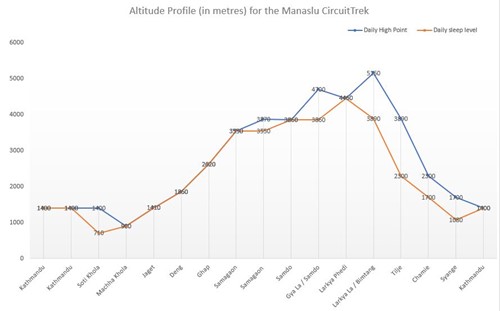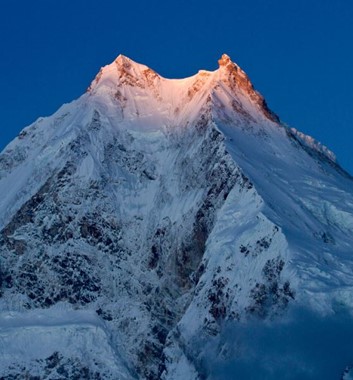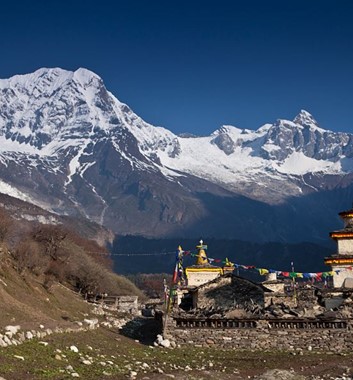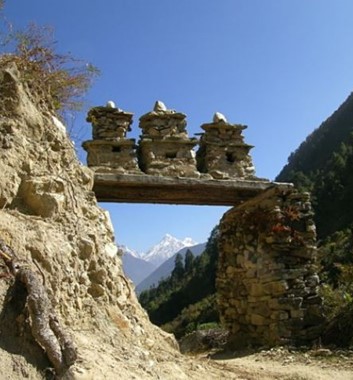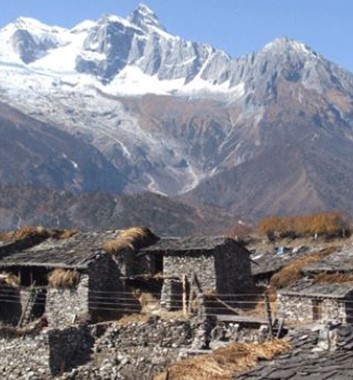Overview
The Manaslu Circuit trek is a stunning 13-day journey (18 days including travel and days in Kathmandu) which treks around the world’s eighth highest mountain, beginning in the busy market town of Soti Khola, going up and back along a different path, ending in Syange. This is a trek for someone who wants something different in Nepal but still offers the most striking and jaw-dropping scenery.
Many people liken the Manaslu Circuit trek to the Annapurna before it got busy! It is in a region which was closed to outsiders until the early 90's and tourism is still restricted. It is also not quite as high as the Annapurna circuit and really is a stunning and less trodden path.
Below is a short clip from independent traveller Tatiana Kolgunova that perfectly captures the essence and beauty of the Manaslu region.
In touch with the Himalayas. Around Manaslu in Nepal, 2016. from Tatiana Kolgunova on Vimeo.
SUMMARY OF THE MANASLU CIRCUIT TREK ITINERARY
The drive from Kathmandu to Soti Khola takes around 8/9 hours and the return drive from Syange to Kathmandu takes around 7/8 hours. The trek ascent is for 9 days, which includes two full days rest and acclimatisation which stay at the same overnight village, to the last settlement of Larkya Phedi. After one day climbing up and over the high point of Larkya La at 5160m with excellend panoramic views of Himlung Himal, Cheo Himal, Kang Guru and Annapurna II), the descent is then another 3 days.
Days 1 & 2: Arrival into Kathmandu, preparation / rest day / sightseeing
Day 3: 8 hr drive to Soti Khola and overnight
Days 4 - 8 : Trek around the Manaslu Circuit - average 6hrs / day to Samagaon
Day 9: Rest and acclimatisation day 3450m
Day 10: Trek to Samdo 3860m
Day 11: Rest and acclimatisation day 3850m
Days 12 - 16: Continue our trek onward to Syange with our peak altitude of 5135m reached on day 10 of the trek or day 13 of the main itinerary when we cross the Larkya La. Average 5hrs / day
Day 17: Drive back to Kathmandu
Day 18: Depart for home
MANASLU CIRCUIT ROUTE MAP
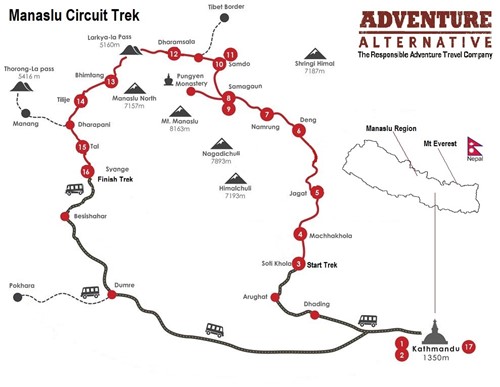
Click on the map for a large version
MANASLU CIRCUIT TREK LENGTH AND TERRAIN
Terrain on the trek is on a well trodden path all the way, though this can be rocky and uneven in parts. It is not precipitous and there is no rock climbing or ‘mountaineering’ which requires equipment. It is a walk all the way, although some of the hills can be steep and never-ending! The Manaslu Circuit trek is 180km in length, roughly 110 miles.
You will meet people along the way, and also yaks. There is only one rule of the road when meeting an oncoming yak, and that is to always ensure you step to one side, towards the inside of the trail, to avoid the cliff edge on the other side! Poles are useful, depending on whether you have problems with knees and if you have a personal preference for using them. Higher up, the open slopes and moraine may give you added reassurance with a pole, but again the path is quite easy to follow.
The highest point of the trek to Larkya La Pass (5135m) climbs steeply, and at times the pass can be slippery so care must be taken. But the path is well used and the ascent is not overly difficult. The approach begins after Samdo village, crossing the high pass is a strenuous day and the exposure to altitude makes the walking harder and the likelihood of altitude sickness higher, hence we have rest and acclimatisation days prior to this and we walk very slowly. This day would be a great objective for a fit hill walker with little mountaineering experience. The top of Larkya La provides astounding panoramic views of Manaslu, Cheo Himal, Himal Chuli and Himlung Himal. The terrain is never dangerous or precipitous, it is still just a walk, but requiring the usual care and caution. There is no climbing or special equipment required on the Manaslu Circuit trek but it is obviously important to have good equipment and adequately prepared for multi-day walking.
Generally, it is hot during the day (up to 20ºC) and cool in the evening (average 5ºC) with little wind and occasional rain showers in the afternoon. After Lho village, the trail enters the Nupri Region inhabited by Tibetan immigrants, where you will find yourself becoming close to culture, religions and local people.
MANASLU CIRCUIT TREK ALTITUDE PROFILE
Click on the image for a larger version.
ACCOMMODATION ON THE MANASLU CIRCUIT TREK
Accommodation on the trek will be in lodges and tea houses run by local families, unless people specify a preference for tents. Each lodge has a central communal area with stove, while the bedrooms are unheated with two beds and mattresses and pillows. You will need to bring a sleeping bag (3 season is normally enough), and the lodge will lend you a blanket if needed. The lodges generally have showers which are powered by gas and they use the infamous ‘drop’ toilets, though some lodges do now use a flush system.
The Manaslu region is not as populated or connected as the busier Khumbu or Annapurna regions and this is a lot of it's attraction, but this remoteness does mean that access to phones and the outside world is less likely or can be days apart. You won't get the pizza or burger options found in other regions but it's authentic and tasty food, warm welcome and stunning scenery is the attraction!
PACKING LIST FOR MANASLU CIRCUIT TREK
Check out our gear recommendations and also our Nepal Trekking Kit List page for information about what gear and clothing we recommend for the Manaslu Circuit trek.
The basic idea of the clothing you will take is to keep you warm, dry, protected from the sun, able to move comfortably in the mountains and able to be comfortable in the evenings and night.
Kathmandu has an area called Thamel which is full of hundreds of equipment shops, each one an emporium of new, used, quality and fake equipment all very reasonably priced for rental and buying. You can buy almost anything needed for any trek.
The basic idea of the kit that you need is to keep you warm, dry, protected from the sun / rain / cold so that you are able to move efficiently on the mountains and able to be comfortable in the evenings and night. Consider the basics:
- BAGS - Large Duffle bag/Rucksack ~80L (for a porter to carry) + Medium Daypack ~40L (carried by you)
- SHELL - Top and bottoms to keep off wind/rain
- INSULATION - Warm layered system to keep you warm- body hands & Head
- BASELAYER - Thin layers to wick away sweat and to strip down to when it gets hot
- FEET - Comfortable, Waterproof boots to support your ankles over rough terrain. Lighter footwaer to change into in the evenings.
- SLEEPING - Warm sleeping bag & Bedroll to get a good nights sleep at the lodges & camps
- EATING/DRINKING - Water bottles & favorite snacks for during the day
- WASHING & MEDICAL - To allow you to wash and maybe stave off a headache or blister
If you have any questions about what kit to bring then to please call or email us. Do consider this is a long trek though it is possible to wash items enroute drying them can at times be difficult.
FREQUENTLY ASKED QUESTIONS (FAQS) FOR THE MANASLU CIRCUIT TREK
HOW FIT DO I HAVE TO BE FOR THE MANASLU CIRCUIT TREK?
Doing a trek for thirteen days straight inevitably is tiring and it's certainly a benefit to be fit, but don't forget that during the trek you are exercising every day and you will end up wonderfully mountain fit and weather beaten! Come back toned, healthy, detoxed and several kilos lighter!
Do train beforehand with lots of walking with a day sack, but don't overdo it. It's not a marathon, but there are lots of hills to go up and down! The high pass is quite challenging too. Work on your thigh muscles, calf muscles and shoulders for carrying the bag (it's only about 5kg but it feels like 10 when you've been walking uphill in the sun). The days aren't too long, the path is fine, and the porters help a lot, but the enjoyment of this trip will be much more if you have worked on your fitness before the holiday.
The trek is not a forced march and the pace is always slow, the days generally being shorter than a day hike at home. You are likely to carry about 5 kilos in your day sack so this is a good weight to work with. If you are going to be using the gym then concentrate on step machines which work on the thigh and calf muscles, and try to build your heart rate up to 50% above resting rate. Any cardiovascular activity is good, but remember that swimming will not train the correct muscle groups so it must be added to other exercises to be effective. Exercise groups like body pump, Pilates and aerobic are all excellent preparation for a trek like this, especially those which work on core strength, balance and stability.
Lightweight hiking boots with a high ankle are recommended for the trek, to protect you against possibly going over on an ankle, heavy boots will be hot and heavy and cumbersome. Cross trainers are popular, but cold in the morning up high.
WHEN CAN YOU TREK THE MANASLU CIRCUIT?
You can trek the Manaslu Circuit from March to June, and September to November. The start dates on the 'Dates & Bookings' tab on our website refer to the arrival date in Kathmandu and the end date refers to the earliest you can book your return flight home for. However, you are welcome to arrive earlier or stay on at the end and stay in our guesthouse in order to spend more time sightseeing in Kathmandu.
DO YOU RUN PRIVATE TREKS OF THE MANASLU CIRCUIT?
We also run private treks for groups of friends, charities, clubs, organisations and corporate groups. The Manaslu Circuit requires a minimum of two people in order to gain the permits. Please do feel free to call or email us to chat about your plans and ambitions.
CAN I FLY BACK AFTER DOING THE MANASLU CIRCUIT TREK?
No problem at all, just contact us for details. Many people when they finish the trek drive to Pokhara for a few days to rest and relaxation and it's possible to fly back from there to Kathmandu.
Do have a read of our various Blogs about treks in Nepal and also the 'More Information' section, both have tabs on this page and will answer every question you may have! We also have a lot of useful information on our Nepal Preparation page.
Dates & Bookings
Itinerary
DETAILED ITINERARY
Day 1 – 1400m Arrival in Kathmandu, transfer to your hotel or our guesthouse.
Day 2 – 1400m Rest day and possibility of a sightseeing tour if you would like to see around Kathmandu. Trek briefing.
Day 3 – 710m (8 / 9 hours) Kathmandu – Arughat - Soti Khola
We will leave Kathmandu in the early morning for a 6/7 hours drive to Arughat then on to Soti Khola were we will stay the night. The last couple of hours can be bumpy though the roads are continually improving.
Day 4 – 900m (5 / 6 hours walking) Soti Khola - Machha Khola.
This morning we ease into our trek by leaving Soti Khola and enter the mystical Sal forest. This is a stunning introduction to the Manaslu Trek as we trek along stunning ridges, cross bridges and walk along winding paths. After crossing the suspension bridge over the Budi Gandaki River, we meander up to Maccha Khola where we’ll spend the night at Machha Khola.
Day 5 – 1410m (6 / 7 hours walking) Macha Khola – Jaget.
We leave Machha Khola and soon reach Khorlabesi, where there is a small natural hot spring. After an uphill section we’ll then cross the Budi Gandaki via a suspension bridge. Today’s trail takes us through forests, along ridges with great views and undulates until we reach our destination and home for the night at the village of Jagat.
Day 6 – 1860m (6 hours walking) Jaget – Deng.
As we leave Jagat we cross a ridge taking us to village of Salleri after which we descend to Sirdibas, then cross, using a large suspension bridge the Buri Gandaki river and later ascend sharply to Philim. After crossing a hillside, we encounter Ekle Bhatti (“lonely teahouse”) before crossing the river again. The trail then enters an amazing part of the gorge, surrounded by orchids on the top. After that, a steep climb to the west side of the valley will lead us through bamboo forests to Deng, where we overnight.
Day 7 – 2620m (3 / 4 hours walking) Deng – Ghap.
Today will be shorter. The trek will take us across a Buddhist influenced region, with a few minor ups and downs, mainly through the forests. We’ll then reach Ghap through a complex Kani with well-conserved paintings and an elegant mani wall.
Day 8 – 3550m (6 / 7 hours walking) Ghap – Samagaon.
In the morning the valley starts of steeply as the path ascends through rhododendron and bamboo forests until reaching Namrung, in the Nupri region. Their inhabitants are descendants of Tibetan migrants who arrived here 500 years ago. You will discover that most Buddhist Gompas, Mani and entrance gates to the village display beautiful Tibetan features and prints. After Namrung we pass across Sho, which offers striking views of Manaslu and Naike Peak. We then pass through Lho, to reach our destination of Samagaon from where the view of Mt. Manaslu breathtaking.
Day 9 – 3550m Today is a rest and relaxation day, or if you'd like to stretch your legs we can take a detour to visit the Pung Gyen monastery then return to Samagaon.
Day 10 – 3860m (4 / 5 hours walking) Samagaon – Samdo.
Today we follow along the Buri Gandaki river and as the valley widens we pass juniper and birch forests until reaching Kermo Kharka. There, the trail descends and passes a wooden bridge; we then reach Samdo after walking through the White Stone Kani. Today can be a bit windy and sometimes exposed but with stunning views.
Day 11 – 4800m Today is an acclimatisation day which will help us prepare for our 5160m journey over the Larkya la Pass in two days time. From Samdo we'll walk up towards the Gya La Pass, which peaks at 5300m, but we won't go to that altitude, based on how people feel we'll aim to reach circa 4600 - 4800m. This pass is the main trading connection / pass with Tibet whose border we'll be very close to. Afterwards we'll drop out of altitude and back to Samdo at 3860m.
Day 12 – 4460 m (3 - 4 hours walking) Samdo – Larkya Phedi.
Our days starts with a descent through beautiful fields to an old stone arch before we cross the river via a wooden bridge to Larka Bazaar. This used to be a thriving market but nothing today remains. An old Mani marks the start of the climb to Larkya La pass. Crossing juniper and tundra we come to a ridge crossing the two ravines at their top. There, we have magnificent views of Larkya Glacier. The climb gets steeper at the side of a gorge reaching 4000m, nearing the glacier. Further up we arrive at Larkya Phedi (4460m) and rest there for the night.
Day 13 – 5160m (7 - 8 hours walking) Larkya Phedi – Larkya La (5160m) – Bimtang (3890m).
Early in the morning, a short walk will take us to the Ablation Valley, on the left side of the Larkya Glacier, which offers amazing views of Cho Danda and Larkya Peak. Following along the glacier moraine we start a steady ascent to Larkya La pass. The path is well trodden and easy to follow. We walk slowly and listen to our body as we gain altitude some may feel nauseous or suffer from headaches. It' important at this stage to drink a lot of fluid and to keep warm. After few hours of walking we reach the top and gaze at the unique sight of Himlung Himal, Cheo Himal, Kang Guru and Annapurna II. Later a steep and sometimes slippery descent to Bimtang awaits us. Trekking poles are useful for this section. The slope gradually becomes smoother when reaching the snow on the moraine, then on from that a small meadow is at 4080m and finally the valley widens as we arrive in Bimtang at 3800m.
Day 14 – 2300m (6 hours walking) Bimtang – Tilje.
Our trek drops down after passing through the meadows to the Dudh Khola river where we cross it via a wooden bridge. We then descend further into rhododendron and pine forests before climbing to a ridge decorated with prayer flags. We then drop again to the riverbank at Gho, where the trail crosses rice fields, rhododendron and oak forests before reaching Tilje.
Day 15 – 1700m (5/ 6 hours walking) Tilje – Chamie
When leaving Tilje, the path crosses the Dudh Khola River and follows the embankment, dropping down through forests until Dharapani (1960m). The path now joins the Annapurna Circuit in reverse and passes the Marsyangdi River and Karte. After an abrupt rocky stairway we reach Tal (1700m). There, a steady descent follows the valley, later crossing Marsyangdi River again before arriving at Chamje, for an overnight stay.
Day 16 – 1080m (3 hours walking) Chamje – Syange
A rocky trail takes us across forests on the edge of a steep sided valley to Jagat. Then, we cross a cliff face and drop down about 150m to Syange (1080m) and the end of our trek. We can relax in the afternoon at our lodge.
Day 17 – 1400m
Today we pack up our boots and leave Syange by car in the early morning to reach Kathmandu about 7 hours later. Lunch will be taken on the way. We then drop you off at your hotel or you can come to our Guest House. There is also the option of a shorter drive to Pokhara and a flight back to Kathmandu, or many people spend a few days of rest and relaxation there before flying back to the capital.
Day 18 – transfer to the airport, and departure from Kathmandu back home, or if you'd like to stay on for a few days you're very welcome.
Cost
Manaslu Circuit Trek: £1695.00
INCLUDES
- Airport transfers
- Accommodation in lodges/tea houses (twin rooms with beds and mattresses)
- All meals on trek, with a hot drink
- National Park Fees & Permit
- Sherpa guides (English speaking, trained in first aid)
- Porters
- Staff food, insurance and equipment
EXCLUDES
- International flight to Kathmandu (~700 -900)
- Accommodation in Kathmandu (~ £15 - £25pp/n) - we can book this for you. Click here for details
- Meals and drinks in Kathmandu (~50-100)
- Personal costs on trek, e.g cold drinks, laundry, hot showers, bottled water (~£70)
- Travel Insurance (~£80-100) must cover trekking at altitude & helicopter rescue in the event of an evacuation
- Visa (~$30)
- Tips (~£60)
- Sightseeing Tours
Payments
A deposit of £100 is required on booking to secure your place and we ask that the remaining balance (trip price minus the deposit) is paid in full 6 weeks prior to your departure. You can also pay by instalments.
Photos
Extras

3 season sleeping bag
A good quality 3 season synthetic mummy shaped bag rated to a low of -12°C and a comfort rating of -5°C. Comes with a liner.

Trekking poles
A pair of adjustable trekking poles.

Hotel Manang
3 nights twin/double standard room in the heart of Thamel in Kathmandu. Hotel Manang is a 4 star establishment with excellent facilities, spacious ensuite rooms and a good restaurant.

Kathmandu Guest House
3 nights B&B in a standard twin or double in the famous 4 star Kathmandu Guest House in Thamel, central Kathmandu. KTMGH is set in beautiful grounds with a number of restaurants and gardens, shops and museum pieces.

Kathmandu Eco Hotel
Budget hotel near city centre, price is for 3 nights double or twin room.
Choose a scheduled date or contact us to set up private dates or a bespoke itinerary. The minimum deposit is £100.00 and the balance is due four weeks before travel.
- Duration 21 days
- Numbers min 4
- Altitude 5160m
- Distance 190km
- Challenge Moderate
- Comfort Lodges/Camping


